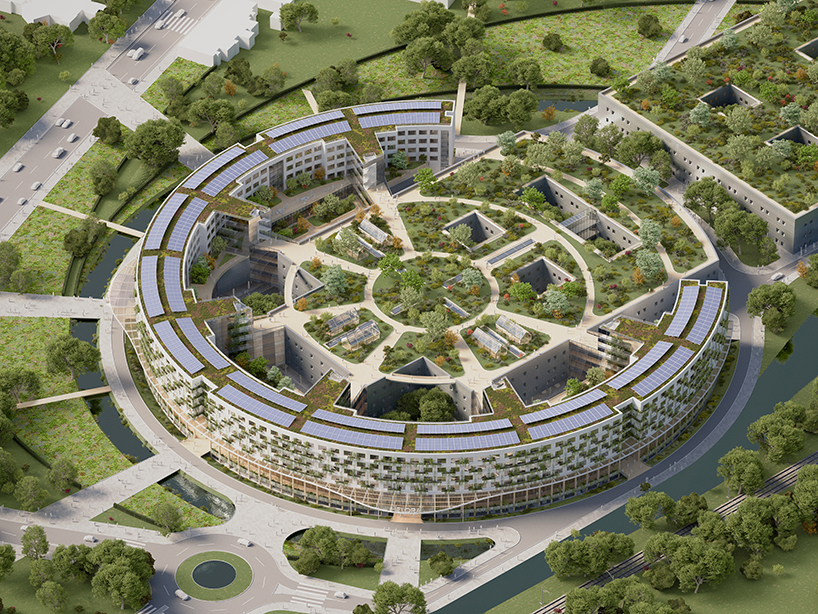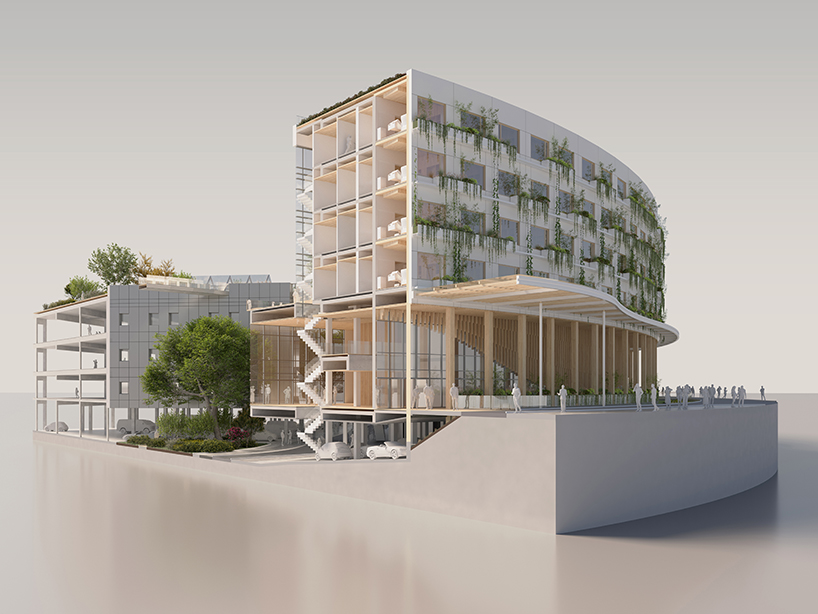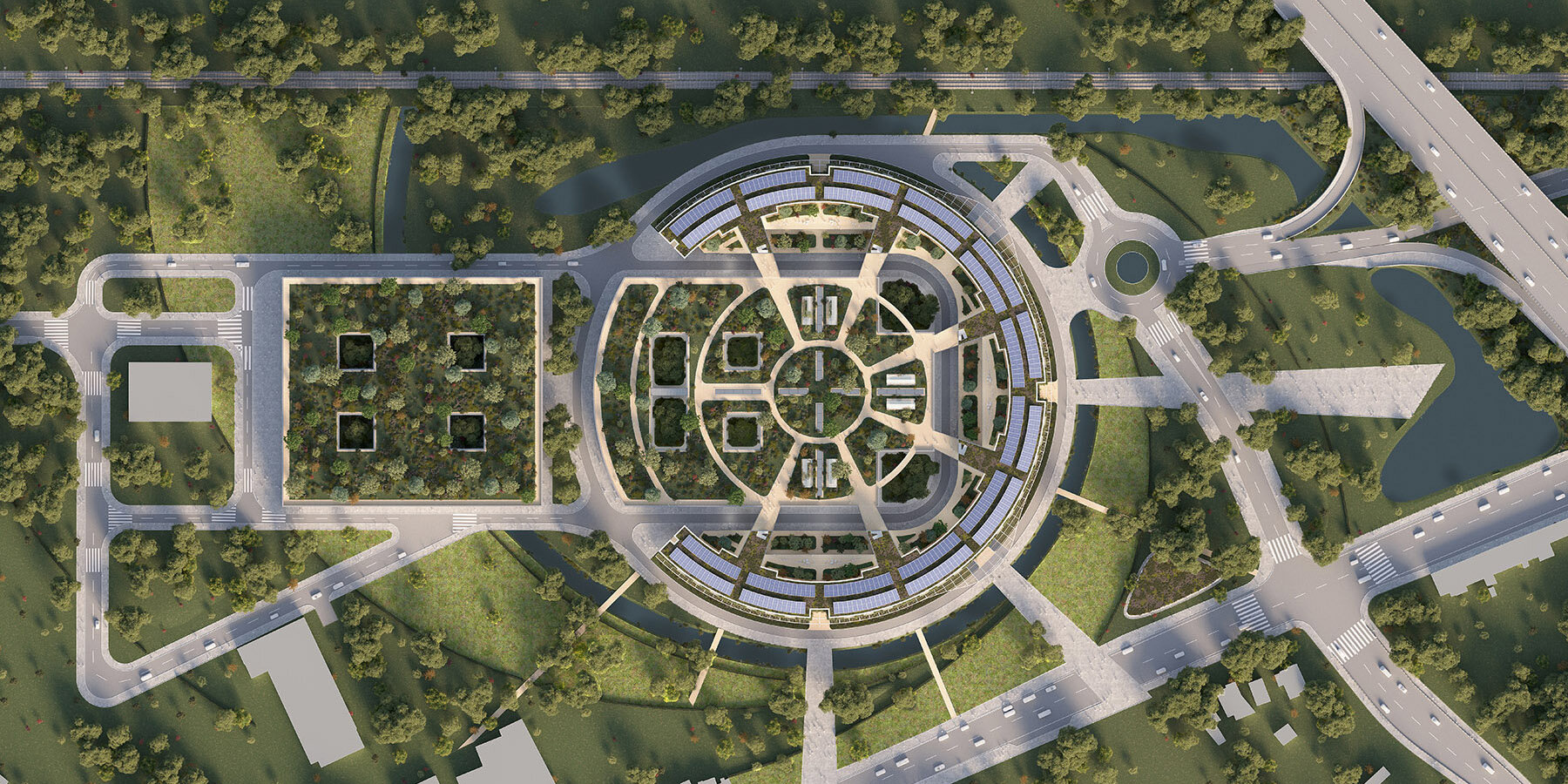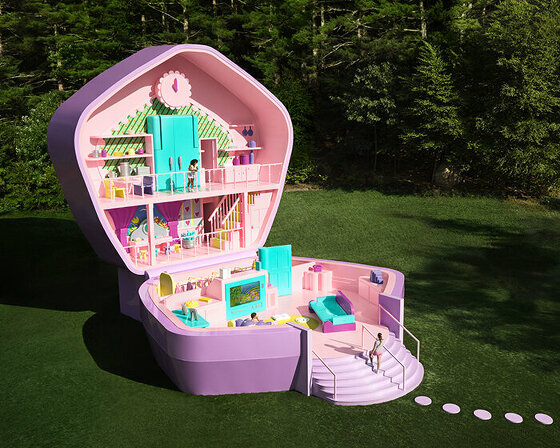BIOPHILIA sees the conception of 5 SUSTAINABLE HOSPITALS in BELGIUM
Vincent Callebaut Architectures presents Biophilia, a vision for future hospitals, redefining traditional models to offer humanistic, patient-centered healthcare. This approach aims to enhance patient experiences, optimize recovery times, and create a peaceful working environment that attracts top healthcare professionals from Belgium and Europe. The design emphasizes sustainability, integrating urban and architectural elements that prioritize the health of patients and staff while harmonizing with the surrounding landscape and urban fabric. The project encompasses the construction of five new hospitals, poised to form the largest hospital network in Wallonia.
This innovative approach establishes a new brand image for hospitals, focusing on five key design principles; organizational efficiency, sustainability and circular economy, off-site hyper-standardization, well-being and biophilia, and landscape opening of sites towards the city.

site plan | all images courtesy of Vincent Callebaut Architectures
Callebaut’s Hospital Design Achieves Organizational Efficiency
Paris-based Vincent Callebaut Architectures presents a prototype of a ‘compact-layers’ hybrid hospital, combining the best elements of compact and layered hospital models to achieve superior spatial efficiency and flow distribution. The design takes inspiration from the ‘Power’ logo, creating a building that integrates medical and accommodation units in a highly functional layout.
The Medical-Technical Block forms the linear segment of the ‘Power’ logo. This block, designed on a 7.8-meter frame for functional modulation, houses operating theatres, endoscopy, and intensive care on the second level, technical and logistics premises on the first level, and emergency and maternity wards on the ground floor. Natural light penetrates this block through strategically placed patios, with the roof transformed into a medicinal garden.
The Accommodation Block forms the circular segment of the ‘Power’ logo, accommodating six units per floor from levels three to five, a day hospital on the second level, consultations on the first level, and administration and visitor reception on the ground floor. Each unit is T-shaped and centered around nursing stations, logistics premises, and elevators. Geometric precision is maintained with standardized room types every 2.5 degrees along the convex facade and every 2.65 degrees along the concave facade.
A 10-meter-wide exterior street separates the two blocks, allowing for the integration of a firefighter route and maximizing natural light. Oblique footbridges span this street every 45 degrees, connecting the T-shaped accommodation units to the Medical-Technical Block.
The entire structure is elevated on stilts, optimizing flow and reducing the footprint’s environmental impact. The parking areas beneath the building are naturally lit and ventilated, facilitating the arrival of technical, logistical, and human flows.
This design, with its distinctive ‘Power’ logo shape, ensures clear spatial organization, fire safety, and easy integration of urban flows. It creates a recognizable and navigable environment for patients, staff, and visitors, effectively unifying the five hospital sites into a cohesive network.

aerial view
Sustainable Low-Carbon Hospitals Emphasize Circular Economy
Vincent Callebaut Architectures’ design for sustainable hospitals focuses on balancing ‘Low-Tech’ and ‘High-Tech’ solutions to create flexible, low-carbon facilities. These hospitals integrate simple construction methods, bio-based materials, and renewable energy systems to ensure scalability and adaptability.
The design employs a mixed construction approach, using low-carbon concrete for the medical-technical block and the spine of the circular ring (central corridor and bathrooms), and cross-laminated timber (CLT) for the accommodation ring. CLT panels are prefabricated off-site, ensuring rapid on-site assembly. The wood is visible on the ceiling and internal facade, enhancing the warmth of the rooms, while the exterior features white ceramic cassette cladding for durability. All joinery in the rooms and curtain walls is made of wood with external aluminum protection. This combination of low-carbon concrete and CLT reduces greenhouse gas emissions during construction.
Energy-saving measures include bioclimatic design for natural ventilation and lighting, and high-performance insulation for thermal comfort in both winter and summer. A geothermal network under the building’s foundations and an 8000 sqm solar farm on the roof of the accommodation ring provide electricity and hot water. The solar roof, covered with sedums and perennials, cools the photovoltaic panels to optimize performance. Information and Communication Technologies (ICT) play a crucial role, from automating flows with robots to developing computerized patient files and optimizing energy consumption and production in real time.
These sustainable hospitals, built with a focus on the circular economy, represent a forward-thinking approach to healthcare infrastructure, blending innovative construction techniques with renewable energy systems.

view from the park
Hyper-standardization, Industrialization, and Repetitiveness
The architects emphasize hyper-standardization in the design of five hospital sites. The project utilizes standardized structural frames and repetitive modules for structural elements, facades, rooms, care units, operating theaters, bathrooms, and furniture walls. This approach extends to roofs, canopies, gardens, planters, and car parks, aiming for industrialized design, ease of maintenance, and flexibility.
The design ensures identical spatial identity across all five sites, making them easily navigable for visitors, patients, and caregivers. The repetitive use of structural elements, facade panels, insulation, and waterproofing systems, along with the ‘all-inclusive’ furniture walls between rooms, maximizes industrialization. This standardization leads to economies of scale in construction and maintenance costs and time.
The design’s spatial agility allows for reversibility, supporting the principles of a circular economy. The black block and white block, initially purposed for medical and accommodation uses, can be repurposed for logistics, sports, commercial spaces, housing, or office buildings, minimizing waste and maximizing long-term usability. This hyper-standardized approach ensures efficiency, cost-effectiveness, and adaptability, reinforcing the project’s commitment to sustainable and innovative hospital design.

aerial view
Biophilic Design for Well-Being in Healing Environments
The architecture integrates biophilic design principles to enhance well-being in hospital environments. This approach connects architecture with natural surroundings and endemic biodiversity, aiming to reduce patient anxiety, staff stress, and improve pain management, overall state of mind, and recovery.
The design combats Urban Heat Islands through plant evapotranspiration which helps reduce summer temperatures by 3 to 5 degrees. Vegetation captures CO2 and converts it to oxygen through photosynthesis, contributing to ‘carbo-absorbing’ architecture and ensuring pollution reduction. Compact building designs enhance rainwater infiltration into groundwater, preserving soil organic richness. Green roofs retain rainwater, which can be stored for cleaning and irrigation. Gray water from kitchens and bathrooms is purified by aquatic plants in lagoons, then reused for irrigation. Green roofs serve as sanctuaries for pollinating species, fostering protection for urban biodiversity.
The concept attends to urban agriculture through the use of green roofs and greenhouses to promote permaculture, offering educational opportunities and strengthening patient-nurse connections. The hospital design includes a public landscaped park with moats and swales, a medicinal garden on the medical-technical block’s roof, green facades along transportation routes, and solar roofs supporting biodiversity. These biophilic elements are integrated to enhance sustainability and create a healing environment.

aerial view
New Hospitals Open to the City Integrating into Urban Landscapes
The design of the five new hospitals by Vincent Callebaut Architectures emphasizes landscape integration and urban connectivity. Each hospital is designed as a landscape intervention, transforming formerly industrial and rural sites into accessible, public-friendly areas.
Projects include the creation of the new Boulevard Urbain de l’Est in La Louvière, the construction of a pedestrian bridge to the ‘K’ wing, and the installation of a new interchange on the Puits 28 site in Mons. Dialogue with the historic architecture of the Warquignies Hospital ensures contextual harmony. The design aims to develop hospital eco-districts that prioritize sustainable development, user flexibility, and high-quality healthcare environments. This approach responds to contemporary ecological and energy transition challenges, embodying Wallonia’s industrial heritage while fostering future growth.
The project aspires to position Wallonia as a center of hospital excellence, influencing Europe and beyond. This vision combines historical acknowledgment with future-forward design, aiming to rejuvenate the region and create a thriving, sustainable healthcare network.

view from the park

model

model

model

model

elevation & section

site plan




project info:
name: BIOPHILIA, 5 sustainable hospitals, Belgium
architect: Vincent Callebaut Architectures | @vincentcallebautarchitectures
client: Helora
associated architects: Assar Inclusive Architecture
structure & MEP: Sweco & Bel
facades: Bollinger & Grohmman
landscape: Land’Act
surface area: 220,000 sqm, 2150 beds
location (5 sites): La Louvière, Mons, Warquignies, Nivelles, Lobbes, Belgium
designboom has received this project from our DIY submissions feature, where we welcome our readers to submit their own work for publication. see more project submissions from our readers here.
edited by: christina vergopoulou | designboom
happening this week! discover riva, the historic brand that blending technology and tradition, reinventing a contemporary, modern, and unique style for fiberglass yachts between 27 and 164 feet in length.
architecture in belgium (144)
healthcare facilities (137)
vincent callebaut architectures (37)
PRODUCT LIBRARY
a diverse digital database that acts as a valuable guide in gaining insight and information about a product directly from the manufacturer, and serves as a rich reference point in developing a project or scheme.




















